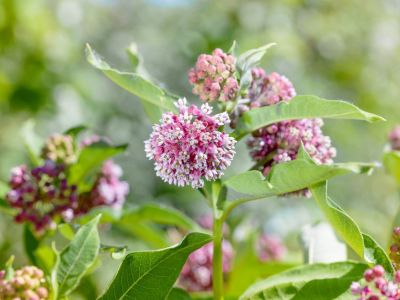In July 2022, the world’s largest environmental network, IUCN, listed the migratory monarch as an endangered species. With numbers declining for years, conservation efforts have been ongoing, and many homeowners added milkweed, the only host plant for the monarch butterfly caterpillar, among their annual and perennial landscape choices.
Milkweed Poisoning and How to Safely Grow Toxic Milkweed
Milkweed is a favorite in butterfly gardens, not only because it is the host plant for the monarch and queen butterflies, but because the nectar is sought by many butterflies, bees, and hummingbirds. Migratory monarch butterflies are decreasing in numbers due to habitat loss as well as climate change. Milkweed, which is common throughout North America, contains either cardiac glycosides or a neurotoxin that is specific to whorled-type milkweed. The toxins can affect heart and kidney function and the nervous system. While horses are most susceptible to milkweed poisoning, people often ask, “Is milkweed poisonous to dogs?” It is toxic to dogs as well as chickens, cattle, sheep, cats, and some insects.
Livestock Milkweed Poisoning
Grazing livestock is at the largest risk of accidental poisoning. Milkweed is a common pasture plant and can pose a threat, especially to horses, if more palatable food is not available and the animals are desperate for forage. They usually avoid eating milkweed, but if that is all that is available, they will eat it. Making sure the livestock always has fresh forage available will help prevent milkweed poisoning. Also develop a weed management plan for fence lines, field edges, and roadsides, where milkweed is commonly found. Eradicating milkweed from pastures is the best way to avoid poisoning. Milkweed is also toxic when dried. If milkweed is baled with hay in the fall, it can be problematic. Inspect hay for dried milkweed before feeding. The whorled milkweed is harder to spot because of its thin stems and leaves. Be especially vigilant if the hay was harvested from areas where milkweed is common, such as field edges.
Symptoms of Milkweed Poisoning
Milkweed poisoning symptoms in animals include abdominal pain, colic, bloat and diarrhea; muscle tremors, weakness; slow, irregular heart rate; or labored breathing. The narrow-leafed milkweed is the most lethal and affects the nervous system. Those include the whorled milkweed (A. subverticillata), the eastern whorled milkweed (A. verticillata) and the plains milkweed (A. pumilla). Broad-leafed species with high levels of toxicity include A. asperula, A. labriformis, A. eriocarpa, and A. curassavica (tropical milkweed). Call a veterinarian immediately if you suspect milkweed consumption. Fresh water, hay and shade will help. Supportive therapies such as sedatives, laxatives, and intravenous fluids may be needed. If contacted in time, vets may be able to administer a therapy to reduce absorption of the toxins. For the home gardener, it is easier to confine your milkweed plants to an area away from curious pets. Common milkweed (A. syriaca), swamp milkweed (A. incarnata) and butterfly weed (A. tuberosa) are planted often in the garden. The tuberosa variety does not have the toxic milky sap and blooms off and on all summer with bright orange flowers. Pollinators flock to the flowers on all milkweed varieties, which also produce interesting seed pods.
Is Milkweed Poisonous to Humans?
When handling milkweed, avoid contact with the milky sap by wearing gloves. If you touch the sap, wash your hands immediately to avoid getting it in your eyes. If you get sap in your eyes you may experience corneal abrasions, edema, loss of corneal transparency and folds in the cornea, which are short lived. Symptoms decrease within 24 to 48 hours.
